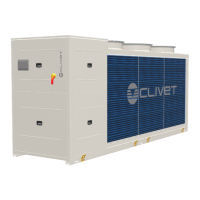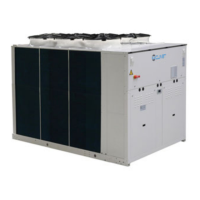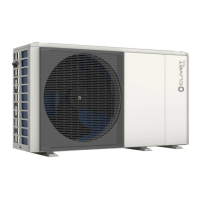
Do you have a question about the CLIVET WiSAN-YEE1 50.4 and is the answer not in the manual?
General safety rules and required protective equipment for operations.
Planning periodic inspections to reduce repair costs and ensuring the unit is off before operation.
Procedures for checking unit delivery for damage and correspondence with documentation.
Importance of unobstructed airflow for efficient operation and avoiding performance issues.
Design considerations for piping to minimize pressure drops and optimize system performance.
Importance of checking water quality against corrosion limits for system longevity.
Procedures for cleaning the system before connecting water to remove residues and impurities.
Measures to protect the unit and connections from freezing temperatures.
Ensuring project water flow meets exchanger limits and system conditions.
Importance and installation guidelines for the flow switch to ensure unit shutdown if water stops circulating.
Proper installation and mesh size requirements for the water filter to prevent particle entry.
Information on unit electrical data, accessories, and matriculation plate details.
Procedures for electrical connections, ensuring isolation, earthing, and cable protection.
Specifies requirements for the power supply network, including voltage, unbalance, and short circuit capacity.
Guidelines for laying signal and data cables, ensuring electromagnetic compatibility and proper shielding.
Details on customer connections to terminal blocks for various functions like pressure switches and heating elements.
Safety checks before working with refrigerants to minimize combustion risks.
Following controlled procedures to reduce risks associated with flammable gases or vapors.
Instruction and monitoring of personnel in the local area regarding intervention nature and safety.
Using detectors to ensure technician awareness of potentially flammable environments.
Ensuring appropriate fire-fighting equipment is readily available during operations.
Strict prohibition of ignition sources to prevent fires or explosions during refrigerant system operations.
Requirement for outdoor or well-ventilated areas for interventions to safely disperse refrigerant.
Checks for systems with flammable refrigerants, including charge quantity and ventilation function.
Initial safety checks and inspection procedures for electrical components, especially in case of faults.
Procedures for repairing sealed components, including disconnection and leak detection.
Acceptable methods for detecting leaks in flammable refrigerant systems.
Procedures for removing refrigerant, purging circuits, and evacuation, considering flammability risks.
Requirements for charging operations, including equipment compatibility and leak testing.
Procedures for safe refrigerant recovery and dismantling of equipment.
Adopting good practices for safe refrigerant removal and transfer into suitable tanks.
Regulations and guidelines for transporting, marking, and storing equipment with flammable refrigerants.
Adherence to safety regulations and use of protective equipment during maintenance.
Maintenance to be performed by authorized centers or qualified personnel for efficiency and longevity.
Safety warnings and procedures for recovering refrigerant and anti-freeze solutions before disconnection.
Risks associated with unit handling, emphasizing the need for protection and compliance with regulations.
Potential risks from incorrect installation, including leaks, shocks, and explosions.
Risks related to electrical connections, incorrect fixing, earthing, and contact with live parts.
Risks associated with refrigerant handling, including expulsion, contact with heat sources, and the need for protective gear.
Technical specifications for Modbus communication, including protocol, speed, data bits, parity, and stop bit.











